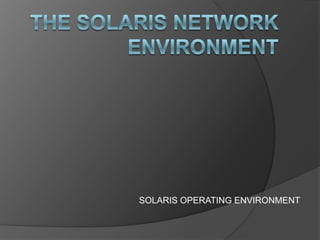
The Solaris Network Environment (Presentation
- 2. The network topologies Network topology is the overall scenerio of network and arrangement in which nodes on a network are connected to each other. It defines in two types: LAN (local area network) WAN(wide area network)
- 3. LAN’s (LocAL AreA Networks) Set of hosts in same building connected by a high speed medium such as Ethernet. Eg . Network setup in a building A LAN might be a single IP network or a collection of networks or subnets that are connected through high speed switches and routers.
- 4. wAN’s (wide AreA Networks) WAN is a network that covers a potentially vast geographical area. Eg . Internet A WAN makes use of third party service providers for interconnection such as different ISP’s.
- 5. Network protocols A network protocol is the part of network that we configure but can’t see. It controlls data transmission b/w systems across the network.
- 6. Network models These are abstract common structure used to describe communication b/w systems. The two network models are : 1. ISO/OSI model ( International Standards Organisation/Open Systems Interconnections) 2. TCP/IP model (Transmission Controll Protocol/Internet protocol)
- 7. 1. ISO/OSI model Application : Utilities such as TELNET and FTP opertate at this layer. layer Presentation : It allows incompatible in the application layer to communicate via layer the session layer. Session layer It handles security and creation of the sessions. Transport TCP operates at this layer layer Network Manages the delivery of data via the data link layer and is used layer by the transport layer. Data-link layer It performs error checking and retransmit frames that are not received correctly Physical layer Describes the network Hardware
- 8. 2. TCP/IP Model Fig :2-The five Presentation Application protocol Session layers of the TCP/IP layering Transport Transport model Network Internet Data link Network interface Physical Physical
- 9. Layer 1: Physical: Layer1 deals with the network hardware . Itcorresponds to the physical layer in the OSI model.
- 10. Layer 2: Network Interface. Thislayer specifies how to organize data into packets called frames and how to address the machines in a LAN. Itcorresponds to the data link layer in the OSI model.
- 11. Layer 3: Internet. Thislayer specifies the format of data packets called IP datagrams and is responsible for delivering these datagrams across the Internet. This layer corresponds to the network layer in the OSI model.
- 12. Layer 4: Transport. This layer has protocols that specify end-to-end (application-to- application) communication. Itcorresponds to the transport layer in the OSI model.
- 13. Layer 5: Application. Thislayer corresponds to layers 6 and 7 in the OSI model that are presentation layer and application layers.
- 14. Encapsulation & decapsulation A header is added to each segment that is received on the way down the layers is k/as ENCAPSULATION. A header is removed from each segment that is received on the way up through the layers is k/as DECAPSULATION.
- 15. ethernet It defines the physical components a machine uses to access the network and the speed at which network runs. An Ethernet network has three main components: data packets, media, and media access (MAC) mechanism. Ethernet uses a protocol called CSMA/CD, which stands for Carrier Sense Multiple Access with collision detection
- 16. Network hardware: Nic’s : The computer hardware that allows you to connect a computer to a network is k/as network interface card. On an Ethernet network, a hardware address is burned into a NIC, but the IP address is not. That means if you change the NIC of your computer, the hardware address of your machine changes.
- 17. HUBS AND SWITCHES : HUB : Each computer is connected to a different port on the hub. A hub receives signal on one port and repeats it on all other ports. SWITCHES: As opposed to a hub, a switch repeats a received signal only on a port to which the intended recipient of the data is connected. When a switch is powered up, it starts off acting like a hub.
- 18. ROUTERS : A router is a machine that forwards packets from one network to another. A hub connects computers and a router connects networks.
- 19. Ipv4 addressing IP (version 4) addresses are 32-bit numbers. Each IP address has a structure—that is, it’s composed of two parts, netid and hostid. All the computers on the same network (e.g.,LAN) have the same netid but different hostids. Netid is assigned by RIR’s and hostid is assigned by local network administrator. IP addresses are assigned by special organisations k/as Regional internet registeries(RIR’s).
- 20. Class A addresses Class A network number falls in the range of 0 to 127.
- 21. By……………….. Mayuresh kumar bhardwaj Some part ofthis presentation is truncated , if you want to know more about it then please contact: Mobile:09627318798 Email id: Solarismayur@live.com gauravb905@gmail.com